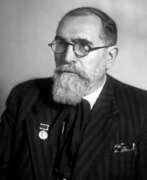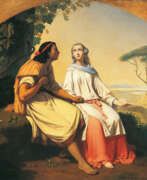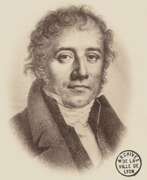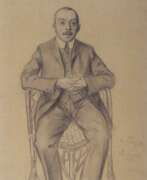Monumentalists 19th century


Karl Pavlovich Bryullov (Russian: Карл Па́влович Брюлло́в), a distinguished Russian artist, emerged as a pivotal figure in the world of 19th-century art, blending Western European Romanticism with his Russian heritage to create works that continue to captivate audiences today. His mastery in painting and architecture set him apart, making him a celebrated figure not just in Russia, but across Europe.
Bryullov's acclaim primarily stems from his remarkable ability to infuse his paintings with vibrant life and emotion, a testament to his profound understanding of human expression and the dramatic interplay of light and shadow. His most famous work, "The Last Day of Pompeii," exemplifies this skill, showcasing an epic narrative filled with vivid detail and emotional depth. This masterpiece, which is housed in the State Russian Museum in St. Petersburg, has garnered international praise for its innovative approach to historical painting, merging accuracy with dramatic storytelling.
Beyond "The Last Day of Pompeii," Bryullov's portfolio includes a range of subjects, from majestic portraits to serene landscapes, each bearing his signature blend of realism and romanticism. His works are featured in prestigious galleries worldwide, serving as a testament to his enduring influence on the art world. For collectors and experts in art and antiques, Bryullov's oeuvre offers a fascinating glimpse into the evolution of 19th-century European painting, marked by a unique intersection of culture, art, and history.
For those intrigued by the enduring legacy of Karl Pavlovich Bryullov and his contributions to painting and sculpture, we invite you to sign up for updates. Our subscription service provides exclusive alerts on new product sales and auction events related to this illustrious artist, ensuring that enthusiasts and collectors alike stay informed about opportunities to engage with Bryullov's remarkable works.


Raoul Dufy, a renowned French artist, is celebrated for his vibrant and decorative style, which left a significant mark in the realms of Fauvism and Post-Impressionism. Born in 1877 in Le Havre, France, Dufy's artistic journey was profoundly influenced by Henri Matisse's Fauvist work "Luxe, Calme et Volupté," which he encountered at the Salon des Indépendants in 1905. This experience steered him towards Fauvism, a style that emphasized bold contours and bright colors.
Dufy's artistic evolution saw him briefly embrace Cubism around 1920, after which he developed a unique approach. This approach, often referred to as stenographic, was characterized by skeletal structures, foreshortened perspectives, and the use of thin, quickly applied washes of color. His works, known for their cheerful and fashionably decorative nature, often depicted scenes of leisure like yachting, the French Riviera, and chic parties, capturing the essence of the period's optimism.
In addition to his painting, Dufy was also a commercial artist, illustrator, and designer, contributing significantly to textile design and public murals. His large-scale public art commissions combined modern and allegorical subjects with exuberant outlines and intense colors, showcasing a modernist take on traditional mural work. Notable works by Dufy include "The Regatta," "The Harvester," and the monumental "The Electricity Fairy," a large mural commissioned for the 1937 World's Fair in Paris.
His works are housed in prestigious public collections worldwide, including the Art Institute of Chicago, the Musée d'Art Moderne de Paris, and the National Gallery of Art in Washington, D.C. Despite his artistic achievements, Dufy's focus on decorative art and the lack of engagement with wider social concerns has led to a varied critical reception of his work. Nonetheless, his contribution to 20th-century art, particularly in popularizing a vibrant and illustrative style, remains undisputed.
If Raoul Dufy's artistry captivates you and you wish to stay informed about the latest artworks, exhibitions, and auction events related to this remarkable artist, we invite you to sign up for our updates. By subscribing, you'll receive timely notifications about new pieces for sale and upcoming auctions. This is a wonderful opportunity for collectors and art enthusiasts to enhance their appreciation and possibly their collections of Dufy's work. Stay connected with the world of art and don't miss any chance to acquire unique pieces by this celebrated artist.


Franz Jakob Julius Götzenberger was a German painter of the first half of the 19th century. He is known as a muralist who specialized in chamber portraits and frescoes with mythological subjects.
Götzenberger spent most of his career in England, but also studied and worked in Rome and Naples. Together with other artists, he created frescoes at the University of Bonn and the church in Nierstein. The master is also known for his pencil portrait of the composer Frédéric Chopin. In 1847, he went to England, where he obtained citizenship and created many portraits and murals.


Gustav Graef was a German painter of the second half of the 19th century. He is known as a painter who specialized in historical and portrait painting.
Graef was commissioned early in his career to create murals for the New Museum in Berlin. One of his famous works was the giant monumental canvas "Charlemagne Adopts Vidukind". The artist also created scenes from the tales of Hercules and Theseus for the Old Museum in Berlin. Then in his genre paintings he moved from mythology to modern history. The master later concentrated on portrait painting, creating idealized female portraits that brought him commercial success. In 1880, at the height of his fame, Graef became a member of the Prussian Academy of Arts.


Louis Kolitz was a German painter of the second half of the nineteenth and early twentieth centuries. He is known as a painter who specialized in depicting historical events, battles, as well as portraits and landscapes.
Kolitz worked primarily in the portrait genre, but he also created monumental works, including murals for official buildings. His portraits and paintings were characterized by realism, detail and mastery of tone, which brought him popularity. Today, his work is recognized as more significant than just the landscape studies and Impressionist paintings of the 1870s. Although critics estimate that Kolitz may have been a pioneer and founder of German Impressionism, he only gained greater fame after his posthumous exhibition in Munich in 1920.


Sergey Dmitrievich Merkurov (Russian: Серге́й Дми́триевич Мерку́ров) was a Soviet sculptor-monumentalist of Greek-Armenian descent, celebrated for his significant contributions to the art world. Born in Alexandropol (now Gyumri), he ventured into art after leaving the Kyiv Polytechnic Institute due to a political scandal. Merkurov's education in art took him across Europe, from Adolf Meyer's tutelage in Switzerland to the esteemed studio of Auguste Rodin in Paris. His acquaintance with Vladimir Lenin abroad influenced his later works, including the famed Lenin statues across Soviet territories. Merkurov's mastery in creating post-mortem (death) masks for notable figures such as Leo Tolstoy and Vladimir Lenin, among others, showcases his exceptional talent and innovation in the field.
An adept of "academic modernism," Merkurov was also involved in the "Monumental Propaganda" program, through which he created numerous significant monuments, including the largest Stalin statues in the USSR. His works, such as the "Shooting of 26 Baku Commissars" and the "Death of the Leader," reflect his artistic prowess and ideological commitment to Soviet monumentalism.
Merkurov's legacy is preserved in the Merkurov Museum in Gyumri, which houses an extensive collection of his death masks, including the only original death mask of Lenin. This museum, opened in 1984 in his family house, stands as a testament to his life's work and influence. His contributions were recognized with titles such as People's Artist of the USSR and membership in the USSR Academy of Arts. Merkurov's works are part of several museum collections, including the State Tretyakov Gallery, underscoring his lasting impact on Russian and Soviet art.
Collectors and art and antiques experts who appreciate the depth of Soviet-era monumental art would find Sergey Dmitrievich Merkurov's works a remarkable study. For updates on exhibitions and auctions featuring Merkurov's work, sign up for notifications to stay informed about new sales and events related to this influential artist.


Johann Jacob Mettenleiter was a German artist of the last quarter of the 18th and first quarter of the 19th centuries who worked in Russia. He is known as a draughtsman, painter, etcher and master of etching.
Mettenleiter was a court painter of the Russian "small court" and an academician of the Imperial Academy of Arts in St. Petersburg. He created paintings of views of Pavlovsk and Gatchina commissioned by Grand Duke Pavel Petrovich and Grand Duchess Maria Feodorovna. His works are of historical interest, as they depict in detail the peculiarities of landscapes and architecture of that time. He also worked as a fresco painter, decorated the imperial family's buildings with plafonds and participated in the painting of churches in St. Petersburg.


August Friedrich Pecht was a German painter of the second half of the nineteenth and early twentieth centuries. He is known as a historical painter and portraitist, lithographer, as well as an art historian and scientific writer.
Pecht's works depicted scenes from the lives and works of famous German writers and historical figures. His most famous paintings include scenes featuring Goethe, Schiller, Henry VIII, and others. Pecht also illustrated various publications and wrote more than 1,500 articles on art. He also left his mark on art with monumental painting, notably decorating the frescoes of the city council hall in Constance.


Philipp Veit was a German painter of the 19th century. He is known as a painter and draughtsman, a representative of Romanticism, a member of the Nazarene group and is considered one of the best colorists among the representatives of this movement. His merits include the fact that he revived the almost forgotten technique of fresco painting.
Veit in his works sought to reflect the ethical and artistic ideals of the German and Italian Renaissance. He actively used the language of medieval symbols, advocating the revival of religious art. His works were distinguished by elaborate composition, monumental images, elegant drawing and contrasting color combinations. In his later works, the artist, influenced by French painting, switched to a more restrained palette.


Peter Joseph von Cornelius was a German painter of the first half of the 19th century. He is known as a painter, draftsman, teacher, and representative of Romanticism.
Von Cornelius was one of the founders of the Nazarene society in Rome and sought to revitalize and modernize German fresco painting. He led the fresco decoration work in Munich and the Ludwigskirche, and was also involved in the design of murals for the Berlin cemetery. The art school founded by Cornelius revitalized mural painting in Germany and influenced other European countries. In addition to monumental works, the artist also created illustrations for literary works including Faust and The Song of the Nibelungs.


Joseph Anton von Gegenbaur was a German historical and portrait painter known for his contributions to the art scene in the 19th century. Born in Wangen, Württemberg, he honed his craft at the Royal Academy in Munich under the guidance of Robert von Langer. Gegenbaur's early works, characterized by their idyllic nature, include altar pieces like "Saint Sebastian" and "Madonna and Child" for his hometown.
Gegenbaur's artistic journey took him to Rome, where he immersed himself in the works of Raphael, and later to Stuttgart, where he served as a court painter, creating frescoes depicting scenes from the history of Württemberg and various mythological subjects. His frescoes, such as "Jupiter giving Immortality to Psyche" and "The Marriage of Cupid and Psyche," showcased his mastery of the fresco medium and his ability to infuse his works with historical and mythological narratives.
Beyond his frescoes, Gegenbaur's oil paintings, including "Adam and Eve after their expulsion from Eden" and "Moses Striking the Rock," further demonstrate his versatility and depth as an artist. His work "Omphale and Hercules" is an example of his mythological themed art, portraying the theme of woman's domination of man, a popular subject in Renaissance and Baroque painting.
For collectors and experts in art and antiques, Gegenbaur's oeuvre offers a glimpse into the 19th-century German art scene, with works that resonate with historical significance and artistic finesse. His contributions to fresco and oil painting remain important for those interested in the evolution of European art and the blend of historical and mythological themes in visual art.
To explore more about Joseph Anton von Gegenbaur's life and works, art enthusiasts are encouraged to delve into detailed studies and collections where his art is featured, enriching their understanding of this notable artist's legacy.


Ludwig von Herterich was a German painter of the late nineteenth and first third of the twentieth centuries. He is known as a painter, teacher, younger brother and pupil of the famous painter Johann Herterich.
Ludwig von Herterich was mainly engaged in portrait and historical-monumental painting, he participated in the artistic design of the Wolfsbrunn Castle in the Ore Mountains. He is considered one of the brightest representatives of the Munich school of painting. He was a member of the Munich Secession and the German Artists' Association. He was awarded the Bavarian Order of Merit for Science and Arts, King Ludwig III also awarded him the Knight's Cross of the Order of Merit of the Bavarian Crown. This entitled the artist to personal nobility and he was allowed to mention his family name with the prefix "von".


Ferdinand von Piloty was a German artist of the second half of the nineteenth century. He is known as a painter, book illustrator, and as the brother of the famous painter Carl Theodor von Piloty.
Von Piloty produced significant works, including five historical frescoes in the Bavarian National Museum and frescoes for the town hall of Landsberg am Lech. The artist's list of famous works includes the historical paintings Thomas More in Prison, Raphael on the Bed of Sickness, and others. Von Piloty was a member of numerous academies and left his mark on the art world, also illustrating Schiller's "The Bell".





















































